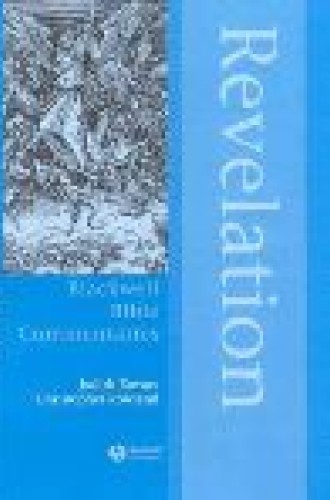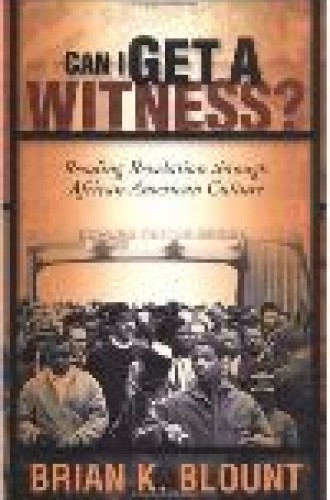Revelation Through the Centuries/Can I Get a Witness?
How many times have you heard someone say, “I don’t know much about the book of Revelation, but I read the Left Behind books, and at least I understand the basics”? Though the Left Behind tsunami has perhaps begun to recede, now is a good time to discuss how we interpret and apply the last book of the New Testament. For those who want more from Revelation than Christian fiction on steroids, I am inclined to recommend a good introduction to the historical and literary context of John’s Apocalypse.
Judith Kovacs and Christopher Rowland take readers on an arduous journey through the depths and heights of apocalyptic hermeneutics. True to the mandate of the Blackwell Bible Commentary series, they focus on reception history—how Revelation has been read and appropriated (“actualized”) across the centuries. Their work is good preparation for reading a second book, in which Brian K. Blount paints a colorful landscape of the actualization of Revelation by the African-American church.
As tour guides through the hermeneutical wilderness, Kovacs and Rowland give each of the 21 chapters in Revelation a two-part treatment. First they provide a brief overview of the ancient literary context of the passage, citing literary precedents that may have inspired John, as well as works contemporary to Revelation that have enlightening parallels. Then, in a more lengthy section on “the interpretations,” they present examples of how Revelation has been actualized by specific interpreters and hermeneutical communities over the past two millennia. Here the authors include references to medieval manuscripts as well as paintings, music, poetry and other artistic media. So, for example, our guides address Revelation 13 with the familiar observation that the first beast finds its primary literary precedent in the four beasts of Daniel 7. Then they point to another parallel in 2 Esdras 13, where monstrous evil takes the form of a man (not a beast) arising from the sea.
With that nod to literary background, Kovacs and Rowland set out to follow the beast through centuries of Christian interpretation. The creature morphs prodigiously, variously representing the Roman Empire, Herod, Nero, Saladin, Anabaptists and America—to name just a few alleged incarnations. We witness the terrible Catholic-Protestant name-calling and see many others join in the hermeneutical mudslinging. Tom Paine called Edmund Burke “the beast” for attacking him. Jehovah’s Witnesses interpreted the beast as the “Anglo-American World Power” as manifested in the League of Nations. The number of the beast (666) has been attached to Muhammad, various popes and emperors, and Hitler. Can any other book of the Bible possibly have generated such a broad spectrum of interpretations?
With each chapter of Revelation, Kovacs and Rowland take us through so wide a range of interpretations that there is risk of information overload. Illustrations do not provide much relief: the entire commentary includes only 13 plates, all black and white. Explaining that costs prevented them from including more illustrations, the authors instead give written descriptions of the art.
Though many of the interpretations that Kovacs and Rowland catalog are sane and serious, the commentary includes some that I could do without, such as the wacky theories of David Koresh and the Branch Davidian cult. Regardless of where readers come down on the interpretative spectrum, they likely will think that the commentary includes a lot of hogwash—simply because interpreters of the Apocalypse have generated a lot of hogwash over the centuries.
A serious argument can be made, however, in favor of pastors and others in the church getting a grasp on hermeneutical hogwash. It is helpful to learn from this commentary, for example, that Revelation has repeatedly provided raw material for self-appointed prophets to make predictions about impending world events. Understanding how routinely such predictions have been wrong may help inoculate today’s church against further rounds of apocalyptic crystal-ball gazing.
Although it would have been beyond the scope of the Blackwell commentary series, I kept wishing that Kovacs and Rowland would critically evaluate the hundreds of interpretations they cite. Rowland is a master interpreter of Revelation who elsewhere has treated the Apocalypse with analytical and theological depth. The authors do offer analysis in a three-page “hermeneutical postscript” at the end of the commentary.
Adjudicating among varying readings, they say, ultimately belongs to the interpretative community, the church. Furthermore, the fourfold narrative of the Gospels must govern any actualization of the Apocalypse, and no application of Revelation that is “at odds with the pattern of Jesus’ life, death and resurrection as found in the gospels” is acceptable. In the light of the Gospels, Kovacs and Rowland argue, the Lamb is the governing image of Christ in Revelation. “The story of the Lamb who is slain offers a critique of human history and of our delusions, of the violence we use to maintain the status quo, and of the lies with which we disguise the oppression of the victim.”
I also wish that Kovacs and Rowland had included some commentary on the relevance of Revelation for assessing the activity of present-day empires. Much as I reject crystal-ball interpretations of the Apocalypse, I cannot read John’s vision without thinking of the beastly empire manifest in the military ventures and political monopolies currently in the news. I cannot read about the “merchants and sea- men and sailors” who mourn the fall of Babylon (Rev. 18) without thinking about the globalization of trade. The centrality of the Lamb in Revelation brings to mind the lamblike reconciliation efforts of Christian Peacemaker Teams. John surely did not predict these developments, but his symbolic representation of faithfulness in the first-century Roman Empire can instruct believers today in discipleship to Jesus Christ.
If Kovacs and Rowland present the broad sweep of interpretation across the centuries, Blount illustrates what actualizing the Apocalypse looks like within one ethnic group. The title of his book—Can I Get a Witness?—suits both the martyr-witness language of Revelation and the experience of the African-American church. More sermon than academic lecture, Blount’s gutsy volume employs a cultural-studies approach. “The goal is not to determine what Revelation meant in John’s first-century community,” he says. Rather, the objective is “to ascertain how material written in and for that community becomes meaningful for a particular twenty-first-century community.”
Contextualizing his reading of Revelation within African-American culture, Blount complains that historical and literary criticism unjustifiably monopolize biblical studies. While historical critics attempt to anchor Revelation in the milieu in which it was originally constructed, the discipline of cultural studies shows “that the reconstruction of that milieu is itself radically influenced by the cultural location of the historian who reconstructs it.” Although ensconced himself in the intellectual haven of Princeton, Blount berates ivory towers and elitism and seeks to read Revelation “from below.” If you do not like his work, he implies, you probably are a snob.
Such posturing makes for provocative reading, and the energy level stays high throughout. Despite his dismissiveness toward other critical traditions, Blount is enough of a historical critic to note that John of Patmos wrote in response to the idolatrous ideology of the first-century Roman Empire. Allusions to the first-century context appear throughout Blount’s text, providing a welcome historical anchor. Sermons, hymns, stories and rap lyrics from the African-American community, meanwhile, present a fresh take on Revelation. With the words of the rap group Public Enemy we get a glimpse of the class consciousness that pervades the Apocalypse:
Power equality, and we’re out to get it
I know some of you ain’t wit’ it
This party started right in sixty-six
With a pro-black radical mix.
Most of the cultural expressions Blount cites, such as this rap lyric, do not derive directly from Revelation. Blount is looking instead for events and sources within the African-American experience that he believes correspond to parts of the Apocalypse.
“White slave owners in the American South were caught in the same predicament as the Romans,” he says. “They didn’t believe in the liberating, transformative power of slave religion.” Like first-century Roman executions, the mutilation of runaway slaves and the lynching of African Americans “brought more witness, not less.” Reaching for a parallel to the frequent worship in Revelation, Blount says that unauthorized worship by African-American slaves was “an expression of resistance.” Here he makes a point that all Christians in North America today need to hear: worship is a profoundly political act that may challenge the prevailing social and political order.
Blount says that the civil rights movement embodied something of the momentum toward liberation that we find in Revelation. Souls under the altar in heaven cry, “How long?” (Rev. 6:10); African Americans similarly cry to God in the face of continuing racial prejudice and injustice. Hymnody in the African-American church retells biblical accounts of divine intervention in the face of suffering, capturing the spirit of God’s sovereignty that pervades Revelation. When Daniel was thrown to the lions, the hymn says,
God sent His angels de lions for to keep
An’ Daniel laid down an’ went to sleep.
There is tension in Blount’s book around the issue of how God’s people respond when divine intervention does not liberate in the decisive way Daniel experienced. On one hand, Blount points to the nonviolence of Jesus the Lamb as the norm: “God’s victorious way is the slaughtered way; it not only describes the path God’s Son took, it prescribes the path God’s people will take on their way to the new heaven and new earth” (emphasis Blount’s). But Blount goes on to assert that, like John of Patmos, slave insurrectionists “believed God would use any means at God’s disposal, including revolutionary violence, to reach God’s emancipatory goal for all God’s people.” Blount is right that Revelation anticipates that insurrection will play a part in bringing down empire (see 17:16-18). But nowhere does John suggest that followers of Jesus will themselves take part in violence.
In an exhortation that would apply equally to much of the majority church in North America, Blount says that the African-American church became unhealthily spiritualized through a “hermeneutic of sacrifice.” This emphasis on sacrifice, exploited by slave owners for centuries, ignored the injustice of slavery, at horrific cost to African Americans. Blount notes that womanist theologians make a similar point about the deleterious impact of a sacrifice hermeneutic on the status of women.
While Blount’s cultural-studies methodology sometimes strikes me as too loose, his book is a good addition to the plethora of historic and literary treatments of Revelation. His essay is something of a North American parallel to Allan Boesak’s 1987 book Comfort and Protest, which interprets Revelation in the context of South African apartheid. Blount’s reading of Revelation through African-American eyes captures the prophetic power of John’s message: the gospel gives marginalized followers of Jesus and other vulnerable people a voice and signals the eventual demise of all oppressive powers.






